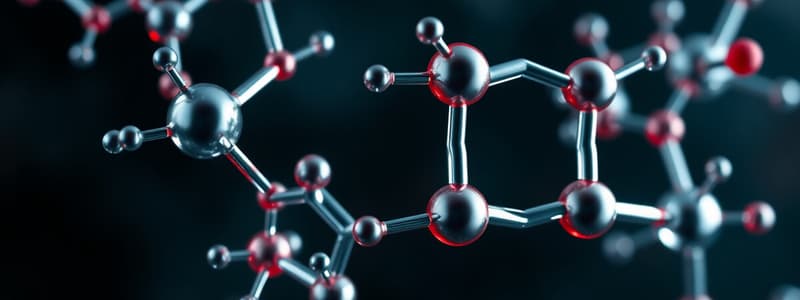Podcast
Questions and Answers
What is the primary reason that atoms generally do not exist freely in nature?
What is the primary reason that atoms generally do not exist freely in nature?
Atoms tend to form molecules because it results in lower energy and increased stability compared to individual atoms.
Explain how chemical bonds are related to energy changes in the atom's system.
Explain how chemical bonds are related to energy changes in the atom's system.
Chemical bonds form when the attraction between atoms leads to a decrease in the system's total energy, indicating greater stability.
Why are molecules considered more stable than single atoms?
Why are molecules considered more stable than single atoms?
Molecules are more stable than single atoms because they are formed through chemical bonds that minimize energy.
Describe the role of electron redistribution in the formation of chemical bonds.
Describe the role of electron redistribution in the formation of chemical bonds.
What occurs during the bond formation process when two atoms approach each other?
What occurs during the bond formation process when two atoms approach each other?
What defines inorganic chemistry and distinguishes it from other branches of chemistry?
What defines inorganic chemistry and distinguishes it from other branches of chemistry?
What are coordination compounds and how are they structured?
What are coordination compounds and how are they structured?
Explain the significance of the periodic table in inorganic chemistry.
Explain the significance of the periodic table in inorganic chemistry.
What is the role of ionic and covalent bonds in forming inorganic compounds?
What is the role of ionic and covalent bonds in forming inorganic compounds?
Describe the differences between alkali metals and alkaline earth metals.
Describe the differences between alkali metals and alkaline earth metals.
What is the coordination number, and why is it important in coordination compounds?
What is the coordination number, and why is it important in coordination compounds?
How do transition metals differ from other elements in terms of oxidation states?
How do transition metals differ from other elements in terms of oxidation states?
What analytical techniques are commonly used to study inorganic compounds and their structures?
What analytical techniques are commonly used to study inorganic compounds and their structures?
Flashcards are hidden until you start studying
Study Notes
Atoms and Molecules
- Atoms typically do not exist freely; they form stable groups called molecules.
- Examples of molecular formations include diatomic molecules like H2 and O2, and polyatomic molecules like P4.
- Molecules are formed when the arrangement of atoms results in lower energy and increased stability compared to individual atoms.
Chemical Bonds
- A chemical bond is the force that holds two or more atoms together, resulting in a stable molecule.
- Bonds involve the redistribution of electrons between atoms, contributing to the stability of the resulting molecule.
- The process of bond formation leads to a decrease in energy, which correlates with the strength of the bond.
- Stronger chemical bonds indicate a more stable molecular structure compared to individual atoms, as seen in molecules like Cl2, HCl, and NaCl.
Chemical Combination
- The formation of chemical bonds is driven by the tendency of atoms to achieve minimum energy states.
- The interaction begins as two atoms approach each other, where one atom's nucleus attracts the other's electrons.
- If the attraction outweighs the repulsion, the system's overall energy decreases, and a chemical bond forms.
- Bond formation is characterized as an exothermic process, meaning it releases energy.
Inorganic Chemistry Overview
- Inorganic chemistry focuses on compounds that lack carbon-hydrogen bonds, distinguishing it from organic chemistry.
Types of Inorganic Compounds
- Salts: Result from acid-base neutralization, consisting of cations and anions.
- Metals and Alloys: Essential components in material science that include pure metals and their mixtures.
- Coordination Compounds: Composed of metal ions bound to surrounding ligands, influencing properties and reactivity.
- Oxides: Compounds formed from oxygen combined with another element, play crucial roles in various reactions.
- Acids and Bases: Included are inorganic examples such as hydrochloric acid (HCl) and sodium hydroxide (NaOH).
Key Concepts
- Periodic Table: Serves as a fundamental reference for understanding elemental behavior in inorganic chemistry.
- Ionic and Covalent Bonds: Essential for explaining the formation and stability of various inorganic compounds.
- Coordination Number: Indicates the number of ligand atoms connected to a central metal atom in coordination compounds.
- Crystal Field Theory: A framework that describes the electronic structure of transition metal complexes, affecting their color and magnetism.
Important Groups
- Alkali Metals: Located in Group 1; known for high reactivity (e.g., lithium and sodium).
- Alkaline Earth Metals: Found in Group 2; reactive metals including magnesium and calcium.
- Transition Metals: Groups 3-12 characterized by variable oxidation states and often colorful compounds.
- Lanthanides and Actinides: Rare earth and actinide series, noted for their complex formation capabilities.
Applications
- Catalysts: Many inorganic compounds facilitate industrial reactions, improving efficiency and selectivity.
- Materials Science: Inorganic materials contribute significantly to advancements in electronics, ceramics, and nanotechnology.
- Biological Role: Inorganic ions such as iron (Fe), copper (Cu), and zinc (Zn) are vital for various biological processes.
Analytical Techniques
- Spectroscopy: Includes UV-Vis, IR, and NMR for analyzing inorganic compound properties.
- X-ray Crystallography: A technique for determining the structures of crystalline inorganic materials.
- Titration: Utilizes volumetric methods to quantify concentrations of inorganic substances effectively.
Safety Considerations
- Toxicity and hazards associated with many inorganic compounds necessitate careful handling and disposal procedures.
- Awareness of Material Safety Data Sheets (MSDS) is critical for safe experimentation and chemical management.
Studying That Suits You
Use AI to generate personalized quizzes and flashcards to suit your learning preferences.




